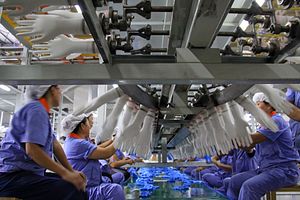Growth predictions for China’s long run issued by the IMF and the Conference Board in recent days have not been positive. The IMF has projected that growth will not reach above 6.5-7 percent in 2015, while the Conference Board projects that China’s growth will slow to 5.5 percent annually between 2015 and 2019, falling to 3.9 percent per year between 2020 and 2025.
China has recently been hit with lower growth as it struggles to emerge from under excessive debt in the corporate sector and restructure its economy. The drag on the economy due to a large amount of debt in fixed asset investment sectors such as real estate has required a pullback in bank lending and reduced growth levels. At the same time, as China turns away from labor-intensive manufacturing to higher value-added manufacturing and services, policies and institutions that assist the restructuring process have lagged behind. GDP growth in the third quarter of this year has been announced at 7.3 percent, lower than the target of 7.5 percent.
At this point, uncertainty reigns. While pledges to restructure the economy were made in the Twelfth Five Year Plan and specified at the Third Plenary Session of the 18th CPC Central Committee last October, few substantive reforms have been made. As Dan Rosen remarked in his report for the Asia Society Policy Institute, while reforms in some areas, like center-local fiscal reform and financial reform have made some progress, progress in other areas such as foreign trade and investment and land, labor and innovation have been less impressive, and signs of resistance are present in all sector. The Fourth Plenary Session is currently in session, but the main focus has been promoting the rule of law. President Xi Jinping and the rest of the Chinese leadership is aware that concerted reform needs to take place but changes have hitherto been slow going.
While the Conference Board report assumes that no significant reform measures will be passed in the coming years to spur growth, some measures are in fact likely to be taken, if China’s economic reform is in keeping with its track record. The Conference Board projections of 3.9 percent in the long run appear to be quite conservative, since China holds comparative advantages in some areas, even though they are changing. China’s comparative advantage has shifted from a relatively unskilled labor force to a higher-educated, higher-skilled labor force, while retaining close supply chain integration with other firms both inside and outside its borders. While past reforms that unleashed China’s former comparative advantage in low-skilled labor consisted of lowering trade barriers, current reforms that seek to complement China’s current comparative advantage in high-skilled labor should focus on lowering barriers to building innovation and modernizing services. This calls for increasing financial liberalization, which China is already moving toward, as well as for increased rule of law and protection of property rights, which China has its sights on.
It appears as unlikely that China will maintain growth levels of 10 percent as that it will maintain growth levels below 5 percent in the coming decade, since the Chinese style of pragmatic experimentation has worked for more than thirty years. Although there is uncertainty in the air, it would be a mistake to underestimate China’s ability to rally its policy organs to implement change. The fact that China was able to transform from a virtually closed, impoverished nation to one of the most successful exporting nations in the world, and from a country that altogether rejected the private economy to one with a “market economy with Chinese characteristics” demonstrates the ongoing capacity of the state to alter the fundamental nature of the economy.
Certainly, analysts who question China’s ability to continue its dramatic reform process point to the lackluster leadership of Hu Jintao. Hu was viewed as an anti-reformist fearful of social instability aroused by change. However, Xi put forth a strong agenda at the Third Plenum last October, and, along with Premier Li Keqiang, continues to underscore the need for economic change. Despite the presence of uncertainty right now, there is reason to believe that those low-ball growth numbers that assume no significant reforms have little basis in fact.

































